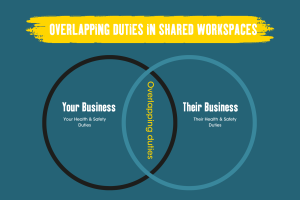The Three C’s: Consultation, Cooperation & Coordination
Feb 12, 2024

In the world of construction, it’s common for duties and health and safety responsibilities to overlap. This can be managed simply – just follow the three C’s – Consultation, Cooperation, and Coordination and you’re on your way to a safer work site!
The role of the Employer
Basically, an Employer is required to ensure the health and safety of their workers, contractors or any visitors who might be affected by work operations.
On-site this means that there can be a lot of overlapping duties, so the principal contractor is responsible for coordinating with other businesses/trades/subcontractors so they can all meet their combined responsibilities. See the image below:

When does this apply?
When there are multiple businesses at the same site, each business must do what they can, within their control, to keep workers safe. In these situations, the most effective way to manage workplace health and safety is by working together.
The Three C’s – Consultation, Cooperation & Coordination
By following the three C’s everyone will be aware of their overlapping duties, so roles can be clearly defined and work isn’t impacted.
Consultation
Consultation between businesses can help you all reach a common understanding and establish clear roles, responsibilities, and actions in relation to work health and safety. Consultation could require discussions around:
- What work activities are being carried out, how and by who
- The degree of influence and control each business has over the workplace (eg. contracts/written agreements)
- Who will manage what and how (eg. notifying incidents)
- What systems will be put in place to monitor compliance (eg. reviewing the site, how often and who by)
- What ongoing communication looks like between themselves and between the workers (eg. toolbox meetings/newsletters/points of contact)
Cooperation
From the consultation comes cooperation. This simply means sharing information and working together to put in place systems for managing and controlling risk agreed during the consultation process. Working together can increase the scope of the hazards recognised – ultimately making the site safer!
Coordination
And last but not least – now actually making sure everything works well together. Businesses should be able to coordinate on what systems will be implemented to control risks. This isn’t about one business pushing all the duties down on another, it’s about everyone involved working together to avoid duplication, or worse, health and safety risks.
The Benefits
What may seem like a hassle at first, is actually a huge benefit to life on-site. Keeping people safe should always be the top priority on any construction site – and of course, Health and safety laws actually require this to be the case. Aligning yourself with other Employers on site and knowing what safety systems are in place is vital and can save lives.
I am a principal contractor, what should I do?
If you are a principal contractor you must document the arrangements in place for consultation, cooperation, and coordination between all the different Employers at your site in your Site Specific Safety Plan (SSSP). The HazardCo system will guide you through creating a SSSP for each of your sites – Test drive the SSSP generator.
Managing your contractors and their H&S responsibilities is easy with the HazardCo system. You’ll get all the tools you need to pre-qualify contractors and check their H&S systems are up to scratch, plus everyone will be able to use the guided HazardCo app on site to create SWMS, log toolbox meetings and more. Get a 7-day HazardCo trial.
If you are a contractor and you have questions on how to best work with other businesses or the process you should follow, have a look at our Overlapping Duties: Working with other businesses blog.














